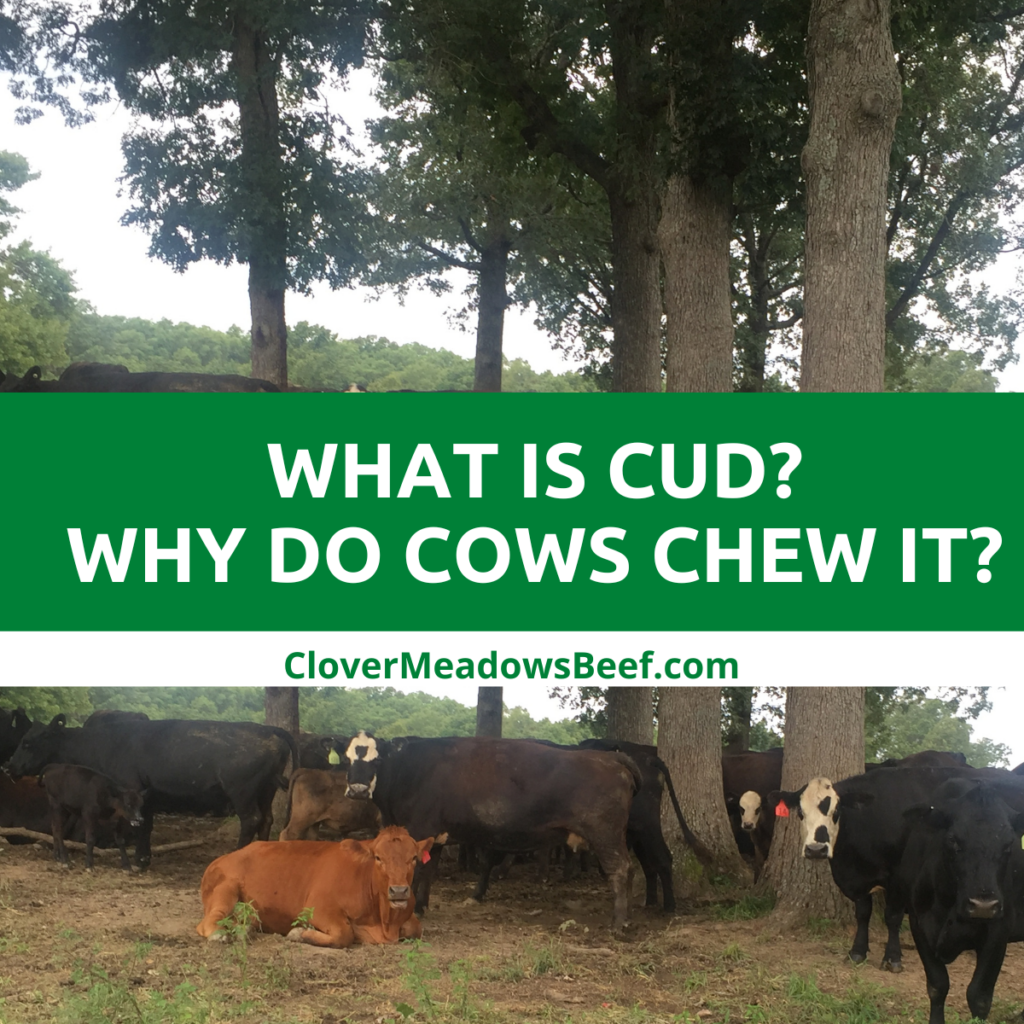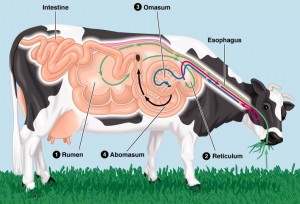Have you ever wondered what is cud? And why do cows chew and re-chew their food? Well, we’re about to unravel the mystery behind how these amazing cud-chewing animals can turn grass into steak by chewing their cud.

Cattle are ruminants
First things first, you have to know that cows are ruminants. Ruminants are mammals that have a unique digestive system with a four-chambered stomach. Unlike us, humans, who have a single-chambered stomach, cows have a complex stomach composed of four compartments: the rumen, reticulum, omasum, and abomasum. Each chamber plays a crucial role in the digestion process, making it highly efficient and capable of extracting maximum nutrients from plant-based diets. In addition to cattle, other ruminant animals include sheep, goats, antelope, and deer, among others.
Jump to:
What is cud?
Cows chew their cud, but exactly what is “cud”? Cud is a semi-digested mixture of food that cows regurgitate from the first chamber of their stomach, the rumen. It’s essentially a small round mass (i.e., a bolus) of partially broken down plant material that’s re-chewed, re-swallowed, and further digested. This unique process of regurgitating and re-chewing their food is what we commonly associate with cows.
Why do cows chew cud?
Now, that you know the background and terminology, we’re finally ready to answer the big question: why do cows chew cud? The answer lies in the efficiency of their digestive system. Ruminants, like cows, rely on microbial fermentation in their stomachs to break down complex plant fibers. Chewing cud helps them break food down into smaller particles, increasing the surface area for microbes to work their magic. This ensures that cows can extract the maximum possible nutrients from their fibrous, plant-based diet.
These microbes and microorganisms in their stomach are responsible for fermenting and breaking down cellulose, the tough plant material that’s difficult for most animals to digest. As cows chew their cud, they create an environment for the microbes to thrive. In return, the microbes produce essential nutrients, such as fatty acids and protein, which cows can absorb and use for growth.
Watch cows chew cud (video)
Have you ever watched a cow chew its cud? If not, you can do it now! This is a video was taken on a typical fall day for our cattle, and it’s what they do year-round, all-day-long.
The Four Stomach Chambers
Now, let’s take a closer look at how food moves through a cow’s four-chambered stomach:
1. Rumen: The rumen is the largest compartment and like a large fermentation vat. It is where microbial fermentation occurs through good bacteria that digest the cow’s food and convert it into energy and protein. Food is initially ingested and then regurgitated as cud, which is re-chewed and mixed with saliva to enhance fermentation.
2. Reticulum: The reticulum functions as a holding chamber for cud before it’s further broken down.
3. Omasum: The omasum is like a sponge, squeezing excess liquid from the cud and absorbing more nutrients.
4. Abomasum: This is the true stomach of the cow, where acid and digestive enzymes work together to break down the cud into simpler molecules for absorption into the bloodstream.

Turning grass into steak
As cattle digest their food, a remarkable transformation occurs. The plant matter consumed by cows undergoes a series of steps that ultimately turn grass into the delicious meat we enjoy on our plates. Here’s the simplified journey from pasture to plate:
1. Grazing: Cows graze on grass, hay, forage and other plant materials, ingesting the tough cellulose fibers found in plant cell walls.
2. Rumen Fermentation: In the rumen, good bacteria and microbes work their magic, fermenting cellulose into volatile fatty acids, which are absorbed into the bloodstream and used for energy. The rumen walls have tiny projections like fingers that improve the surface area for absorbing nutrients.
3. Omasum’s Secret: The omasum absorbs excess liquid, ensuring that only the most nutrient-rich material continues on to the abomasum.
4. Abomasum Digestion: In the abomasum, acid and enzymes break down the remaining cud into amino acids, essential nutrients, and minerals.
5. Nutrient Absorption: The cow absorbs these nutrients through the intestinal wall into the bloodstream, where they travel to various parts of the cow’s body for growth and maintenance.
6. The Steak: Over time, with the right nutrition and care, the nutrients support muscle development and fat accumulation, eventually turning into the delectable cuts of beef we savor.
The Bible and “Chew the Cud”
As a side note, the Bible also mentions animals that “chew the cud” in several verses, such as Leviticus 11:3-26 and Deuteronomy 14:6-8. In the Bible, if an animal had a “cloven foot” (a hoof split into two distinct toes) AND “chewed its cud”, it was “clean” could be eaten. Example of these animals would be cows, oxen, sheep goats and deer. If an animal did not have a cloven hoof, it was forbidden to eat it. An example of these animals are the camel, hare (rabbit), and hyrax (badger).
Conclusion
So, there you have it! Cows are not just your average, everyday farm animals. They are complex cow-chewing creatures with a digestive system that is nothing short of miraculous. Their ability to turn grass into the steak on our plates is a superpower. The next time you see a cow peacefully chewing its cud, you’ll know that they are hard at work, making the most of their plant-based diet so that you can have steak.
ONE MORE THING!
Do you want to learn more about beef? Join our weekly e-newsletter where we share farm happenings, recipes and beef availability. Sign-up and get a cheat sheet with 9-must-ask questions before buying beef directly from a farmer. Or, we have an entire ebook about beef that goes through purchasing and preparing beef from a cattle farmer’s perspective.
Here are a few other links about cattle you may like:
- The difference between a bull, steer, cow and heifer (video)
- What is grain finished beef?
- What is grass fed beef
- Cows 101: Do cows have teeth? (video)
- Making hay and feeding it to our cattle
- What do cows drink? Water? Milk?
- What do cows eat?
- Do cows get cold in winter?
- 27 amazing facts about cows that will impress your friends
This post contains affiliate links. Please see our disclosure policy for more information
We participate in the Amazon Services LLC Associates Program, an affiliate advertising program designed to provide a means for us to earn fees by linking to Amazon.com and affiliated sites. See our disclosure policy for more details

